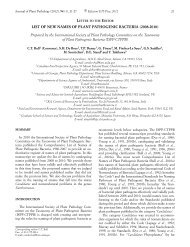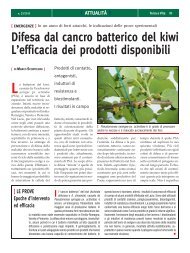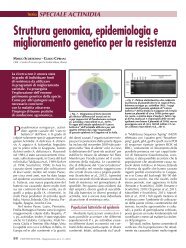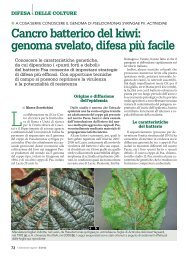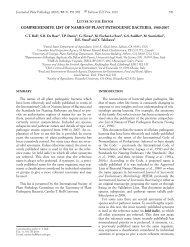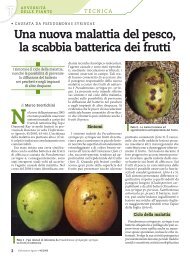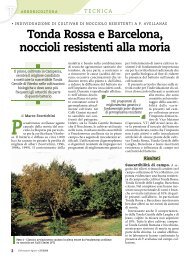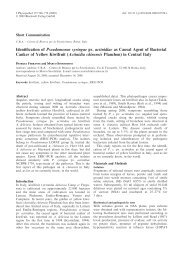Genetic Diversity of Xanthomonas arboricola pv. fragariae Strains ...
Genetic Diversity of Xanthomonas arboricola pv. fragariae Strains ...
Genetic Diversity of Xanthomonas arboricola pv. fragariae Strains ...
You also want an ePaper? Increase the reach of your titles
YUMPU automatically turns print PDFs into web optimized ePapers that Google loves.
116 Scortichini and Rossi<br />
Strain Host plant CountryYear <strong>of</strong> isolation<br />
<strong>Xanthomonas</strong> <strong>arboricola</strong> <strong>pv</strong>. pruni<br />
NCPPB 416 T P. salicina New Zealand 1957<br />
NCPPB 417 P. salicina New Zealand 1957<br />
NCPPB 926 P. domestica South Africa 1961<br />
NCPPB 1607 P. persica Australia 1964<br />
NCPPB 2587 P. armeniaca South Africa 1964<br />
NCPPB 2588 P. persica South Africa 1964<br />
NCPPB 3156 P. persica Italy1981<br />
NCPPB 3877 P. salicina Italy1990<br />
NCPPB 3878 P. salicina Italy1991<br />
ISF FXP1 P. salicina Italy1995<br />
ISF FXP2 P. salicina Italy1995<br />
ISF FXP3 P. persica Italy1995<br />
ISF FXP11 P. salicina Italy2000<br />
ISF FXP12 P. salicina Italy2000<br />
ISF FXP13 P. salicina Italy2000<br />
ISF FXP14 P. salicina Italy2000<br />
Unknown xanthomonads<br />
ISF F26 Frag. x an. Italy1999<br />
ISF F29 Frag. x an. Italy1999<br />
ISF F30 Frag. x an. Italy1999<br />
ISF F31 Frag. x an. Italy1999<br />
Table 1<br />
(Continued)<br />
T : Pathotype strain; Frag. x an. :Fragaria vesca x ananassa; C. avellana: Corylus avellana; J. regia: Juglans<br />
regia; P. armeniaca: Prunus armeniaca; P. domestica: Prunus domestica; P. salicina: Prunus salicina;<br />
P. persica: Prunus persica.<br />
NCCPB: National Collection <strong>of</strong> Plant Pathogenic Bacteria, York, United Kingdom; PD: Plant Protection<br />
Service, Wageningen, The Netherlands; BPIC: Culture Collection <strong>of</strong> Benaki Phytopathological<br />
Institute, Kiphissia-Athens, Greece; IVIA: Instituto Valenciano de Investigaciones Agrarias, Moncada-<br />
Valencia, Spain; ISF: Culture Collection <strong>of</strong> Istituto Sperimentale per la Frutticoltura, Roma, Italy.<br />
reddish 15–18 days after the inoculation. Blackening<br />
<strong>of</strong> the veins and a subsequent necrosis <strong>of</strong> the leaf tissue<br />
was observed 1 month after the inoculation. Afterwards,<br />
a chlorotic halo was, sometimes, noticed<br />
around the necrotic tissue. The leaf blight symptom<br />
was observed onlyin some symptomatic leaves showing<br />
necrosis and chlorotic halo, approximately<br />
2 months after the inoculation. <strong>Xanthomonas</strong> <strong>arboricola</strong><br />
<strong>pv</strong>. <strong>fragariae</strong> strain PD 2780 (pathotype strain) was<br />
the most aggressive, causing blight in four leaflets,<br />
whereas ISF F 23 inciting blight onlyon one leaflet<br />
was the least aggressive. The blackening <strong>of</strong> the peduncle<br />
was observed onlyin some cases and mainly<br />
with strain PD 2780 that induced such a symptom on<br />
three <strong>of</strong> the six inoculated peduncles. Isolates ISF F 26<br />
and ISF F 30 induced onlya slight discoloration<br />
around the inoculation site that never developed into a<br />
necrotic tissue. Re-isolations on GYCA performed<br />
from symptomatic leaflets and peduncles yielded yellow-pigmented<br />
colonies identical to X. <strong>arboricola</strong> <strong>pv</strong>.<br />
<strong>fragariae</strong> upon SDS-PAGE.<br />
On the basis <strong>of</strong> biochemical tests, SDS-PAGE comparison<br />
<strong>of</strong> protein extract pr<strong>of</strong>iles with type and reference<br />
strains <strong>of</strong> X. <strong>arboricola</strong> <strong>pv</strong>. <strong>fragariae</strong> and<br />
pathogenicitytests, we conclude that the 14 isolates listed<br />
in Table 1 belong to X. <strong>arboricola</strong> <strong>pv</strong>. <strong>fragariae</strong>. ISF<br />
F 26, ISF F 29, ISF F 30 and ISF F 31 could not be classified,<br />
although, probably, they are xanthomonads.<br />
Repetitive PCR genomic fingerprinting<br />
ERIC, BOX and REP primer sets gave reproducible<br />
genomic PCR pr<strong>of</strong>iles consisting <strong>of</strong> bands <strong>of</strong> approximately100–1700<br />
bp. The bands were clearlydifferentiated<br />
byPAGE. For UPGMA analysis, a total <strong>of</strong> 41<br />
reproducible, clearlyresolved bands were scored: 18<br />
for primers ERIC, 14 for primer BOX and nine for<br />
primer REP. ERIC and BOX primers were more discriminative<br />
than REP in differentiating the X. <strong>arboricola</strong><br />
<strong>pv</strong>. <strong>fragariae</strong> strains. Representative genomic<br />
patterns are shown in Fig. 1–4. *UPGMA analysis<br />
Fig. 1 Polymerase chain reaction fingerprinting patterns from<br />
genomic DNA <strong>of</strong> <strong>Xanthomonas</strong> <strong>arboricola</strong> <strong>pv</strong>. <strong>fragariae</strong> and putative<br />
xanthomonads strains, obtained byusing enterobacterial repetitive<br />
intergenic consensus primer sets. m: molecular size marker (1-kb ladder,<br />
Gibco BRL, Life Technologies, Italy); the sizes are indicated in<br />
base pairs. Lane 1: ISF F 29; lane 2: ISF F 30; lane 3: X. <strong>arboricola</strong><br />
<strong>pv</strong>. <strong>fragariae</strong> PD 2697; lane 4: X. <strong>arboricola</strong> <strong>pv</strong>. <strong>fragariae</strong> PD 2696;<br />
lane 5: X. <strong>arboricola</strong> <strong>pv</strong>. <strong>fragariae</strong> PD 2782; lane 6: X. <strong>arboricola</strong> <strong>pv</strong>.<br />
<strong>fragariae</strong> 2695



